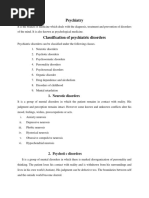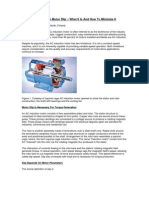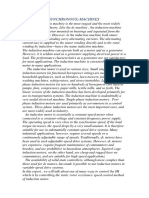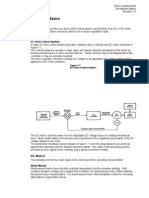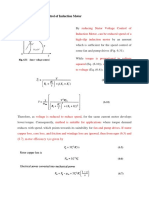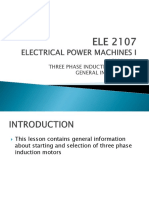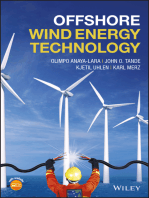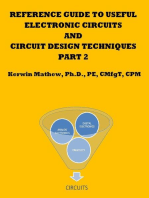0 ratings0% found this document useful (0 votes)
68 viewsRotor Resistance Control of Induction Motor
Rotor Resistance Control of Induction Motor
Uploaded by
ali.en122Rotor resistance control of induction motors allows the motor speed to be varied by adjusting the rotor resistance. This keeps the motor's maximum torque constant while lowering speed with increased rotor resistance. It provides high torque at low speeds, making it useful for applications with intermittent loads like cranes. While low-cost, it reduces efficiency due to resistor losses. Modern static rotor resistance control uses a transistor and diode bridge to continuously vary rotor resistance without steps, allowing smooth speed control with fast response.
Copyright:
© All Rights Reserved
Available Formats
Download as PDF, TXT or read online from Scribd
Rotor Resistance Control of Induction Motor
Rotor Resistance Control of Induction Motor
Uploaded by
ali.en1220 ratings0% found this document useful (0 votes)
68 views4 pagesRotor resistance control of induction motors allows the motor speed to be varied by adjusting the rotor resistance. This keeps the motor's maximum torque constant while lowering speed with increased rotor resistance. It provides high torque at low speeds, making it useful for applications with intermittent loads like cranes. While low-cost, it reduces efficiency due to resistor losses. Modern static rotor resistance control uses a transistor and diode bridge to continuously vary rotor resistance without steps, allowing smooth speed control with fast response.
Copyright
© © All Rights Reserved
Available Formats
PDF, TXT or read online from Scribd
Share this document
Did you find this document useful?
Is this content inappropriate?
Rotor resistance control of induction motors allows the motor speed to be varied by adjusting the rotor resistance. This keeps the motor's maximum torque constant while lowering speed with increased rotor resistance. It provides high torque at low speeds, making it useful for applications with intermittent loads like cranes. While low-cost, it reduces efficiency due to resistor losses. Modern static rotor resistance control uses a transistor and diode bridge to continuously vary rotor resistance without steps, allowing smooth speed control with fast response.
Copyright:
© All Rights Reserved
Available Formats
Download as PDF, TXT or read online from Scribd
Download as pdf or txt
0 ratings0% found this document useful (0 votes)
68 views4 pagesRotor Resistance Control of Induction Motor
Rotor Resistance Control of Induction Motor
Uploaded by
ali.en122Rotor resistance control of induction motors allows the motor speed to be varied by adjusting the rotor resistance. This keeps the motor's maximum torque constant while lowering speed with increased rotor resistance. It provides high torque at low speeds, making it useful for applications with intermittent loads like cranes. While low-cost, it reduces efficiency due to resistor losses. Modern static rotor resistance control uses a transistor and diode bridge to continuously vary rotor resistance without steps, allowing smooth speed control with fast response.
Copyright:
© All Rights Reserved
Available Formats
Download as PDF, TXT or read online from Scribd
Download as pdf or txt
You are on page 1of 4
Rotor Resistance Control of Induction Motor:
Speed-torque curves for Rotor Resistance Control of Induction Motor are
given in Fig. 6.50. While maximum torque is independent of rotor
resistance, speed at which the maximum torque is produced changes with
rotor resistance. For the same torque, speed falls with an increase in Rotor
Resistance Control of Induction Motor.
Advantage of Rotor Resistance Control of Induction Motor is that motor
torque capability remains unaltered even at low speeds. Only other
method which has this advantage is variable frequency control. However,
cost of Rotor Resistance Control of Induction Motor is very low compared
to variable frequency control. Because of low cost and high torque
capability at low speeds, rotor resistance control is employed in cranes,
Ward Leonard Ilgener Drives, and other intermittent load applications.
Major disadvantage is low efficiency due to additional losses in resistor
connected in the rotor circuit. As the losses mainly take place in the
external resistor they do not-heat the motor.
Conventional Methods:
A number of methods are used for obtaining variable resistance. In drum
controllers, resistance is varied by using rotary switches and a resistance
divided in few steps. Variable resistance can also be obtained by using
contactors and resistors in series. High power applications use a slip-
regulator, which consists of three electrodes submerged in an electrolyte,
consisting of saline water. Resistance is varied by changing the distance
between electrodes and earth electrode. When the power is high,
electrodes are driven by a small motor. Advantage of this method is that
resistance can be changed steplessly.
Static Rotor Resistance Control:
Rotor resistance can also be varied steplessly using circuit of Fig. 6.51. The
ac output voltage of rotor is rectified by a diode bridge and fed to a
parallel combination of a fixed resistance R and a semiconductor switch
realized by a transistor Tr (Fig. 6.51).
Effective value of resistance across terminals A and B, RAB, is varied by
varying duty ratio of transistor Tr, which in turn varies rotor circuit
resistance. Inductance Ld is added to reduce ripple and discontinuity in
the dc link current Id. Rotor current waveform will be as shown. in Fig.
6.5104 when the ripple is neglected. Thus rms rotor current will be
Resistance between terminals A and B will be zero when transistor is on
and it will be R when it is off. Therefore, average value of resistance
between the terminals is given by
where δ is the duty ratio of the transistor and is given by Eq. (5.112).
Power consumed by RAB is
From Eqs. (6.88) and (6.89), power consumed by RAB per phase is
Equation (6.90) suggests that rotor circuit resistance per phase is
increased by 0.5R(1 – δ). Thus, total rotor circuit resistance per phase will
now be
RrT can be varied from Rr to (Rr + 0.5R) as δ is changed from 1 to 0.
A closed-loop speed control scheme with inner current control loop is
shown in Fig. 6.52. Rotor current Ir and therefore, Id has a constant value
at the maximum torque point, both during motoring and plugging. If the
current limiter is made to saturate at this current, the drive will accelerate
and decelerate at the maximum torque, giving very fast transient
response. For plugging to occur, arrangement will have to be made for
reversal of phase sequence.
Compared to conventional Rotor Resistance Control of Induction Motor,
static rotor resistance control has several advantages such as smooth and
stepless control, fast response, less maintenance, compact size, simple
closed-loop control and rotor resistance remains balanced between the
three phases for all operating points.
You might also like
- Care and Training of The Trotters and PacersDocument184 pagesCare and Training of The Trotters and PacersLazar SimicNo ratings yet
- Psychiatry BookDocument157 pagesPsychiatry BookSanaullah67% (3)
- Subject: Electric Drives & Traction Topic: Rotor Resistance Control of 3-Ø Induction MotorDocument3 pagesSubject: Electric Drives & Traction Topic: Rotor Resistance Control of 3-Ø Induction MotorImran JamadarNo ratings yet
- Unit-Iv Rotor Side Controlled Induction Motor DriveDocument34 pagesUnit-Iv Rotor Side Controlled Induction Motor DriveChinnu ChinniNo ratings yet
- DR BU Static Rotor Resistance ControlDocument4 pagesDR BU Static Rotor Resistance ControlSameer GulshanNo ratings yet
- Slip RecoveryDocument26 pagesSlip RecoverySrdjan MilosavljevicNo ratings yet
- Unit-IV Speed Control of Induction Motor On Rotor SideDocument8 pagesUnit-IV Speed Control of Induction Motor On Rotor SideMohammed MateenNo ratings yet
- Ain Shams University Faculty of Engineering Chep Energy SeniorDocument12 pagesAin Shams University Faculty of Engineering Chep Energy Seniorbanana_26No ratings yet
- Lecture Note - ED - Rotor Resistance ControlDocument3 pagesLecture Note - ED - Rotor Resistance ControlsashaikhNo ratings yet
- AC Induction Motor SlipDocument6 pagesAC Induction Motor SlipnotastudentNo ratings yet
- A Three Phase Induction Motor Is Basically A Constant Speed Motor So ItDocument39 pagesA Three Phase Induction Motor Is Basically A Constant Speed Motor So ItManish MakwanaNo ratings yet
- Speed Control of DC Motor Using PWMDocument23 pagesSpeed Control of DC Motor Using PWMSunitha MaryNo ratings yet
- DC Motors Starters and Breaking MethodsDocument25 pagesDC Motors Starters and Breaking MethodsRukkuArunNo ratings yet
- DC Motors Starters and Breaking MethodsDocument25 pagesDC Motors Starters and Breaking Methodskrishnareddy_chintalaNo ratings yet
- Edc Unit 5Document27 pagesEdc Unit 5GopinathNo ratings yet
- Design and Development of Chopper Based Speed Control of Slip Ring Induction Motor2012-1Document7 pagesDesign and Development of Chopper Based Speed Control of Slip Ring Induction Motor2012-1Suman KarmakarNo ratings yet
- Assignment 3Document3 pagesAssignment 3yisakabera123No ratings yet
- Speed Control and Starting of A DC MotorDocument56 pagesSpeed Control and Starting of A DC MotorCarlos Arias LuyandoNo ratings yet
- Synchronous MotorDocument5 pagesSynchronous Motornaga531No ratings yet
- Article 50 Ijaet Volii Issue IV Oct Dec 2011Document6 pagesArticle 50 Ijaet Volii Issue IV Oct Dec 2011Pradyumna PooskuruNo ratings yet
- ELE 576 Lecture VIDocument14 pagesELE 576 Lecture VIiscnaniNo ratings yet
- 1 Introduction 2. TheoryDocument33 pages1 Introduction 2. TheorychikulenkaNo ratings yet
- 04 SpeedControl IM PDFDocument10 pages04 SpeedControl IM PDFKazi Newaj FaisalNo ratings yet
- Semester Questions 1stpartDocument77 pagesSemester Questions 1stpartPratim GhoshNo ratings yet
- Module 3: Induction Motor Drives: SyllabusDocument8 pagesModule 3: Induction Motor Drives: SyllabusManoj SkNo ratings yet
- DC 2 Characterstics of DC MCDocument13 pagesDC 2 Characterstics of DC MCsunil bangarNo ratings yet
- Starting: and of Three Phase Induction MotorDocument8 pagesStarting: and of Three Phase Induction Motoraamir ahmedNo ratings yet
- Induction (Asynchronous) Machines 1.1Document9 pagesInduction (Asynchronous) Machines 1.1Areej AdeebNo ratings yet
- Starters & Speed ControlDocument47 pagesStarters & Speed ControlcoolkannaNo ratings yet
- Electrical Drives (ARG)Document24 pagesElectrical Drives (ARG)alu bhindiNo ratings yet
- EDC Unit 5Document41 pagesEDC Unit 5Dr Harsha AnantwarNo ratings yet
- Speed Control of DC MotorDocument19 pagesSpeed Control of DC MotorVijaya LakshmiNo ratings yet
- Amplifier ServoDocument3 pagesAmplifier ServoinputzNo ratings yet
- Unit Iii Switched Reluctance MotorDocument18 pagesUnit Iii Switched Reluctance MotorMürlî MünnâNo ratings yet
- Speed Control of DC MotorDocument18 pagesSpeed Control of DC Motorkrishnareddy_chintalaNo ratings yet
- Speed Control of DC Motor by Using PWM TechniqueDocument51 pagesSpeed Control of DC Motor by Using PWM TechniqueYuvraj GogoiNo ratings yet
- DriveMotorBasics01 PDFDocument11 pagesDriveMotorBasics01 PDFSundar Kumar Vasantha GovindarajuluNo ratings yet
- ReportfinalDocument44 pagesReportfinalYuvraj GogoiNo ratings yet
- Ac and DC ServomotorDocument11 pagesAc and DC ServomotorchrisroyelectoNo ratings yet
- Question BankDocument5 pagesQuestion BanklalitaerankiNo ratings yet
- Lecture 6Document31 pagesLecture 6amanuel abrehaNo ratings yet
- Convergence 47Document5 pagesConvergence 47janni.junnaNo ratings yet
- Fuzzy - Microsoft Word - IJEST11-03-10-070Document8 pagesFuzzy - Microsoft Word - IJEST11-03-10-0702K18/EE/244 VIPESH DUNKWALNo ratings yet
- 7 Wound Rotor Induction Motors - AC Motors - Electronics TextbookDocument6 pages7 Wound Rotor Induction Motors - AC Motors - Electronics TextbookSchuldich SchwarzNo ratings yet
- Module 2 - Switched Reluctance MotorDocument20 pagesModule 2 - Switched Reluctance MotorkesavantNo ratings yet
- 04 Chapter 3_ac DrivesDocument46 pages04 Chapter 3_ac Drives2022977659No ratings yet
- Dr. Ali Abdul Razzaq ALTAHIR: Lecture 6: Third ClassDocument20 pagesDr. Ali Abdul Razzaq ALTAHIR: Lecture 6: Third ClassAli Altahir100% (1)
- SRD-vehicle Traction Applications PDFDocument20 pagesSRD-vehicle Traction Applications PDFEduardo BittencourtNo ratings yet
- Rotor Chopper Speed ControlDocument15 pagesRotor Chopper Speed ControlRohithNo ratings yet
- Servo MotorDocument17 pagesServo MotorAswathy SimonNo ratings yet
- An Application of Matlab/Simulink For Speed Control of DC Series Motor Using Buck ConverterDocument5 pagesAn Application of Matlab/Simulink For Speed Control of DC Series Motor Using Buck ConverterArghya MukherjeeNo ratings yet
- Speed Control of DC MotorDocument31 pagesSpeed Control of DC Motorabhinav. alpheus651997No ratings yet
- Unit IV Full Material GK DubeyDocument39 pagesUnit IV Full Material GK Dubeysuresh krishnanNo ratings yet
- Comparing The Performance of Induction MDocument9 pagesComparing The Performance of Induction MIraqi stormNo ratings yet
- Speed Control of Three Phase Slip Ring Induction Motor at Variable Load ConditionDocument3 pagesSpeed Control of Three Phase Slip Ring Induction Motor at Variable Load Conditionhi100% (1)
- Unit 3Document50 pagesUnit 3coolbadyakashNo ratings yet
- ELE 2117 Lesson 11Document42 pagesELE 2117 Lesson 11elioNo ratings yet
- Control of DC Motor Using Different Control StrategiesFrom EverandControl of DC Motor Using Different Control StrategiesNo ratings yet
- Reference Guide To Useful Electronic Circuits And Circuit Design Techniques - Part 2From EverandReference Guide To Useful Electronic Circuits And Circuit Design Techniques - Part 2No ratings yet
- Barrie Sharpe - Review of Literature On JosDocument9 pagesBarrie Sharpe - Review of Literature On JosStephen SparksNo ratings yet
- SAP Certified HCM Consultant: Samantha-Robinson-2a90286Document15 pagesSAP Certified HCM Consultant: Samantha-Robinson-2a90286Nandini maskeNo ratings yet
- 5 6231815 PDFDocument13 pages5 6231815 PDFpkiytdNo ratings yet
- Flexible Budget Examples (Chapter 18)Document9 pagesFlexible Budget Examples (Chapter 18)Muhammad azeemNo ratings yet
- Unit 4Document9 pagesUnit 4kr.gokul9940No ratings yet
- Ram Post ReflectionDocument4 pagesRam Post Reflectionapi-402053549No ratings yet
- Book ReviewsDocument11 pagesBook ReviewsPaul KlyushinNo ratings yet
- TUBEX TF Technical LeafletDocument2 pagesTUBEX TF Technical LeafletFARLIANNo ratings yet
- Els / Lys - Z 0 1 7: İngilizce Deneme Sinavi (7)Document17 pagesEls / Lys - Z 0 1 7: İngilizce Deneme Sinavi (7)Ahmet ÖlçerNo ratings yet
- (For Public) Doctrines - Taxation & Commercial LawDocument19 pages(For Public) Doctrines - Taxation & Commercial Lawmovieclipsonline28No ratings yet
- Name of Ship / Flag: Srikandi Indonesia / IndonesiaDocument4 pagesName of Ship / Flag: Srikandi Indonesia / IndonesiaJoy Mitrady PanjaitanNo ratings yet
- Student Project Management System: March 2021Document12 pagesStudent Project Management System: March 2021Teckzhi TanNo ratings yet
- Lohp PrintDocument3 pagesLohp PrintCabague Marien Olivia KrystelNo ratings yet
- Fraction, Decimal and PercentDocument24 pagesFraction, Decimal and PercentTricia Nicole DimaanoNo ratings yet
- Bank of America Case AnalysisDocument11 pagesBank of America Case Analysiskanabaramit67% (3)
- Software TestingDocument142 pagesSoftware TestingAbdulraheman100% (2)
- NCP DR 1Document2 pagesNCP DR 1jay kusainNo ratings yet
- Social Problems Among TeenagersDocument1 pageSocial Problems Among TeenagersWinnie Lau100% (2)
- Affirmations GuideDocument7 pagesAffirmations GuideGiridhar Adithiyha100% (1)
- 72038622R10007 - Development Assistance Specialist Senior Health Lead Hyderabad Consulate FSN-12 HODocument11 pages72038622R10007 - Development Assistance Specialist Senior Health Lead Hyderabad Consulate FSN-12 HOAbha MahapatraNo ratings yet
- eDocument114 pagesePercy Cusihuaman TorresNo ratings yet
- NGAKONI KALUPUTAN - AlangalangkumitirDocument7 pagesNGAKONI KALUPUTAN - AlangalangkumitirafifbawasantosaNo ratings yet
- My Student Journal EntryDocument13 pagesMy Student Journal Entryapi-212499894No ratings yet
- ProCAM Installation GuideDocument90 pagesProCAM Installation GuideRenato SchendroskiNo ratings yet
- LyricsDocument21 pagesLyricsHilan Gel GulmaticoNo ratings yet
- Thesis Book ContentDocument3 pagesThesis Book ContentKristine MalabayNo ratings yet
- Art Subject For Elementary - 1st Grade - Music by SlidesgoDocument56 pagesArt Subject For Elementary - 1st Grade - Music by Slidesgobasantescarlos277No ratings yet
- NKF Kidney Transplant Application Form B1Document8 pagesNKF Kidney Transplant Application Form B1Ainaa FarhanaNo ratings yet

